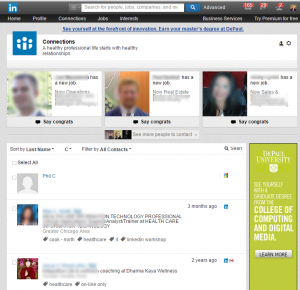LinkedIn Profile – is it yours or not?
Years ago as LinkedIn became more popular, I noticed people who left their jobs and abandoned their profiles. In some cases, it may have been a non-compete situation, or it may have been a lost password. Some folks just didn’t know that they could add new work experience to their existing profile.
Now that LinkedIn allows you to start a profile at the age of 14 in the United States, individuals who start at that early age will definitely own their profile.
“Minimum Age” means (a) 18 years old for the People’s Republic of China, (b) 16 years old for the Netherlands, (c) 14 years old for the United States, Canada, Germany, Spain, Australia and South Korea, and (d) 13 years old for all other countries. However, if law requires that you must be older in order for LinkedIn to lawfully provide the Services to you (including the collection, storage and use of your information) then the Minimum Age is such older age. The Services are not for use by anyone under the age of 13.
Who owns the contacts on your profile?
If you have been using LinkedIn for a number of years and have built your connections up, you may be a valuable commodity to an organization who wants to broaden their reach. Personally, I worked for an organization where one of my major duties was to network and spread the word about the services offered by that organization. Everyone I met was added to my LinkedIn connections if they had a profile.
If your company relies upon you to be their data collector, shame on them. They should employ a CRM of some sort to track their clients, not your LinkedIn profile. In my case, not everyone I met was because of the organization for which I worked. I was involved in community organizations, a family business, and other activities where I met people besides on the job.
The biggest reason you need to be aware of company policy for any organization for which you work is what they deem as appropriate use for their clients in your contacts. This news item from February 2015 on a Fox News Station in St. Louis reminds us to read what you are signing when you enter into an employment agreement with any company. Know whether your clients can be your connections. If you bring a robust profile with you, your profile is yours, but the connections you gain related to your employment may become the non-compete property of the company.
Fortunately, with the tagging function in LinkedIn, you can easily tag any new connections with a tag related to that company so you know down the road what you can or cannot do with that connection.
It is a different situation if you are managing company profiles. Whatever the contacts are that follow a company social media profileIf you are personally
This brings up another question: What happens to your contacts if you bring contacts to the table when you are hired? I asked Jim Voigt of Lavelle Law to help me out with an answer. Here is what he offered:
- In the rare situation where you actually have an employment contract, the use of your contacts should be spelled out;
- If there is and employer handbook, you need to review it to see if your employer is making a claim to your contacts – read it! Even if that claim is made, it does not mean the employer will prevail. But it is at least good to know that your employer considers your contacts to belong to the company so you can head off misunderstandings early.
- Whether an employer could legitimately make a claim to your contacts would very much depend on the circumstances. Were you hired specifically because you had several, or perhaps certain key contacts? Were you separately paid for those contacts beyond your regular salary and benefits?
- Analysis in any potential law suit will be very fact specific. If an employer is making a claim to your contacts, it would be worth your time to at least talk it over with an attorney. Most attorneys offer a free initial consultation.
Here is my profile tip to you:
Make sure you have at least two email addresses associated with your LinkedIn Profile. People will often invite you to connect based upon the email address that they have for you. It isn’t the correct way, but it happens. When you have a work and personal email address, you will always have access to your account. If you get terminated, just go into your account and switch which email address is your primary email address.
Let us know if you have any social media needs with which we can assist you!